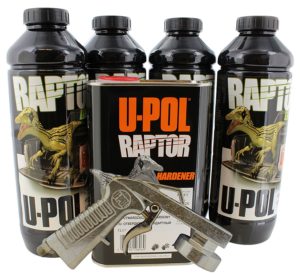Contact us Now!
Review thanks to shedheads.net
July 5th, 2017: We've received a few emails from readers who've sprayed their own truck bed. Based on their input, we've now updated this article. We now strongly recommend against doing a single coat, two coats gives a much better finish. We've also added some important safety notes about wearing a respirator. If you've sprayed your own truck bed, please drop us a line in the comments! We'd love to hear your experience.
Looking to get your truck ready for the next four wheeling season? Many consumers are turning to raptor liner to protect their truck beds. They've quickly become one of the bestselling spray of bed liner manufacturers on the market. But what exactly is it? And what kind of results should you expect? We'll be taking an in-depth look at this popular product to find out if it's something that you should trust your vehicle with, or if it's just another over marketed add-on.
What is Raptor Liner Paint?
Raptor liner is an all-inclusive kit that contains almost all of the materials needed for vehicle enthusiasts to protect their investment. Once installed, it dries into an ultra-hard coating that can protect bare metal from chips, scratches and stains, and the inevitable rust that comes along with it. What separates them from competing products is the look and feel. The first generation of bed liner was actually molded plastic that would sit inside your box. The disadvantage to this system was that bed liners had to be pre-manufactured for certain vehicles, and the cost of shipping made them prohibitively expensive for many consumers. But this product uses a spray-on formula that bonds directly to the contours of your vehicle. Because there is no air gap, less cargo space is lost. Because it comes in a spray, Raptor's unique chemical formula allows them to bond the material with a number of dyes and pigments, so you can get a color that matches the paint of your vehicle.
How Should Spray on Bed Liner be Used?
Raptor bed liner started out as an easy way for truck owners to protect their cargo area, but it's grown to be much more than that. Today, Raptor liner is in use in all kinds of industries from automotive restoration, off-roaders, marine, agricultural, and even with heavy equipment.
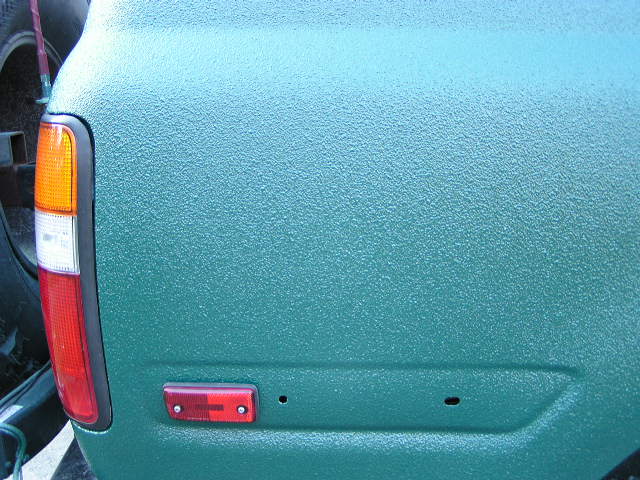
No matter how you intend to use this unique spray on bed liner, the process is pretty straightforward. First, you make a rough estimate of the area you need to cover. You then order the kit, and clean the surface. Then, just like a can of spray paint, you shake the can and apply. After a brief time to dry, your metal is protected.
How Raptor Liner Can Protect Your Vehicle
On a basic level, it serves to protect the metal of your vehicle. It's reasonably thick and even though it feels hard to the touch it has the ability to disperse pressure. Let's say, for example, that you threw a generator into the back of your truck. If it was to bounce around, the force with which it impacts your truck bed could cause dents. This is because there is a lot of pressure applied to a very small area. But when the same force is applied to your newly applied protective coating, it flexes just enough to disperse the pressure so you don't damage your vehicle. This elasticity is also what allows it to hold solid to your vehicle as well. Driving, even on rough roads, isn't going to cause it to crack or chip like other coatings.
But there are a few other key reasons why people use spray on bed liner. It's UV resistant, so it won't fade or discolor like paint will. Heavy machinery and farm equipment is often given a coat as it doesn't react with animal urine or engine lubricants.
Is It Worth It?
We have to admit, once we learned all of the above, we were intrigued. We decided to try Raptor Liner out for ourselves. After getting some firsthand experience, we learned a few things that you should be aware of before you consider this product yourself.
What You Need
The Raptor DIY Spray in Bed Liner comes in a kit that includes, for the most part, everything you need. Each kit contains four bottles, totalling about 3 liters of liner. You also get a gun to help you spray it on, and some sandpaper.
What they don't tell you is that you'll need a few tools. Most of you will have an orbital sander, but if you don't, these are very easy to find. You'll also need an air compressor. We recommend a minimum of 5 gallon capacity. It's basic, but gets the job done. The reason you need 5 gallons or more is because specific air pressure is needed to get the desired textured finishes. If you go for your typical low volume compressor, you're going to spend a lot of time waiting for the compressor to build up pressure, and this can easily double the time it takes to apply. It goes on very quick, so it's well worth the money to rent a larger compressor for a couple days while you complete the project, if you're not interested in buying one.
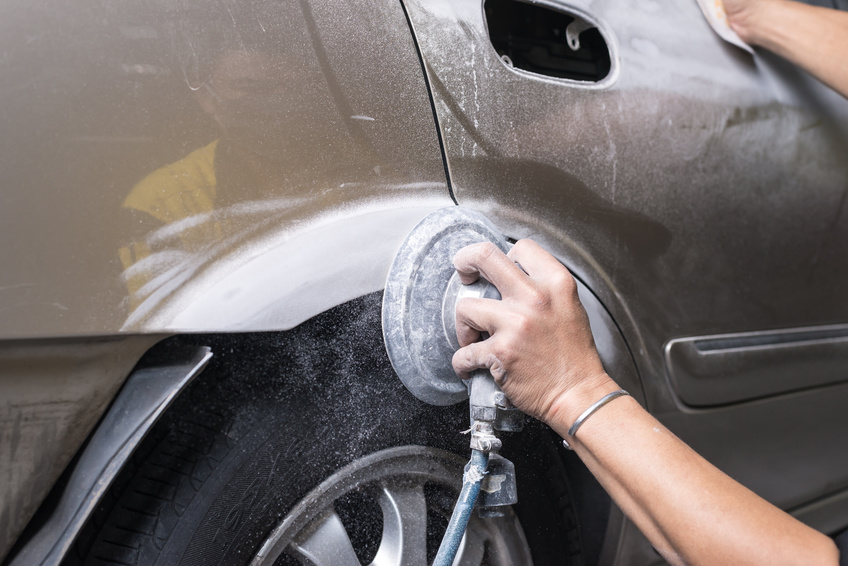
Step 1: Prepping the Surface
In order for the coating to stick, it needs a rough surface. You'll have to use the included 3M pads to scuff up the box of the truck to make it rough. The entire process took us about two hours for a half ton truck. You might feel that you can do this much faster, but it's important to take your time. By looking at the paint in the sunlight, you'll see pretty clearly if you missed any areas. Doing it right the first time will be much quicker than rushing through the job and having to touch up all of the problem areas.
Just like when you paint a vehicle, many people recommend that you wipe your box down with a tack cloth . Although this isn't required, this will help remove any dust from your box, and improve bonding. If you don't own a tack cloth and you're on a budget, one alternative is to hose your box down, dry it with a microfiber cloth or towel (make sure that it's solid, and doesn't leave any residue!)
Step 2: Tape
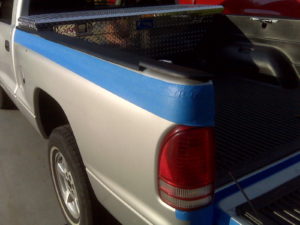
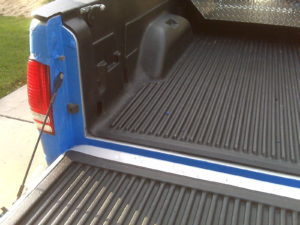
If you look at most truck bedliners, you'll notice that it actually comes out of the box a little and covers the top. To get a nice clean line, you'll want to run a strip of tape where you want the liner to stop. We'd recommend stretching the tape out about a foot past where you're sticking it, then run your hand along the side of your truck in a smooth manner. This makes a nice clean line, giving you a very professional look.
Step 3: Spray

The included gun screws right into the top of your paint bottle and your compressor attaches at the back. Reading the directions, we found that the amount of air pressure you use determines the finish. Typical finished jobs will have a rough, patchy feel to them. In our opinion, this is the way to go. It's a slightly tougher finish, and helps keep things in place so they're not sliding around in your box. But if you want a smoother finish, you can go as high as 100 PSI or as low as 30 PSI. 30 PSI is typically used for people who are using the bed liner as a finishing tool. If you're doing your fender flares or painting your rocker panels, set the pressure lower. If you're using the product as intended (in your truck bed), we highly recommend that you use the manufacturers recommended pressure of 50 PSI.
As for the spraying itself, it's very simple. As with anything, you want to start the spray pointed away from the vehicle, then slowly move your hand above the area to be painted in a smooth motion. If you've ever painted a car yourself, or seen videos where people are painting their own cars, this is much easier. This video gives a good example of proper spraying technique:
Raptor liner doesn't bead or pool up like paint does and it goes on thick. They recommend two coats. The trick with this is to make your first coat very light. It's fine if it seems a little uneven or splotchy. Just focus on making nice smooth, even passes. Move quickly, and don't let it pool up. When you're doing your second coat, you'll be able to move slower and lay it down thicker. Because you'll already have a layer, this second coat will be much more even. Many people have been able to do this in a single coat by using a higher air pressure, but we found that you get much more professional results with a single coat.
If you've done a good job, you should be pretty much finished at this point. But we'd really recommend a second set of eyes to check over your work. You might have small areas that you've missed, and it's important to touch these up before it dries. If you're spraying indoors, now is a great time to reverse out of your garage and set it in the sun. The bright light will make it easier to spot imperfections.
Safety Tip: Protect Your Lungs
The kit includes a basic paper respirator. The fumes from truck bed liner can be harmful. Although most people will spray indoors (to prevent leaves, pollen, and flying debris from mucking up your paint job) it's a good idea to crack your garage window and turn on a fan.
Your respirator should have a tight seal. With the paper ones, we recommend being clean shaven. You can also tie a knot on the elastic band to make it fit tighter.
Paper respirators don't work for everyone. Here is a simple test you can do to see if you have a good seal: with the mask on, take a deep breath through your nose and mouth. you will feel more resistance than normal if the mask is tight. Do you feel cool air rushing past the sides of the respirator? If so, you don't have a good fit.
You're already saving a ton of money by spraying your own truck, so don't risk your health. Proper respirators are available at every hardware store and should always be used when sanding, spraying or grinding.
The Final Verdict
Would we use this product again? Absolutely! It's extremely durable, easy to apply, and affordable. If you're using it for its intended purpose, this is hands down one of the best bed liners on the market.
Would we use it to paint our entire vehicle? Maybe. It is commonly sold as a cheap alternative to a DIY paint job. In many ways this is true. You can paint right over the old paint, and don't need to pay as much attention to small dings and dents. Applying raptor liner is much, much easier than automotive paint. Plus, it will hold up to much more abuse.
But you should consider the texture - it is rough. It's not anything like the smooth finish you'd get with typical paint. If you're off-roading and getting rock chips is a very serious threat, then this coating is the way to go. The look comes off as very aggressive, and would suit a self-built 4×4 vehicle easily, plus it's functional.
This isn't the kind of finish you'd want to put on your mom's civic. Raptor liner is built to be tough and ideal for any vehicle where that's a factor. If you're really unsure, we're recommend doing the rocker panels of your car and the fender flares. This can look good on any vehicle, and it's a small enough area that you won't be committed to the entire thing.








